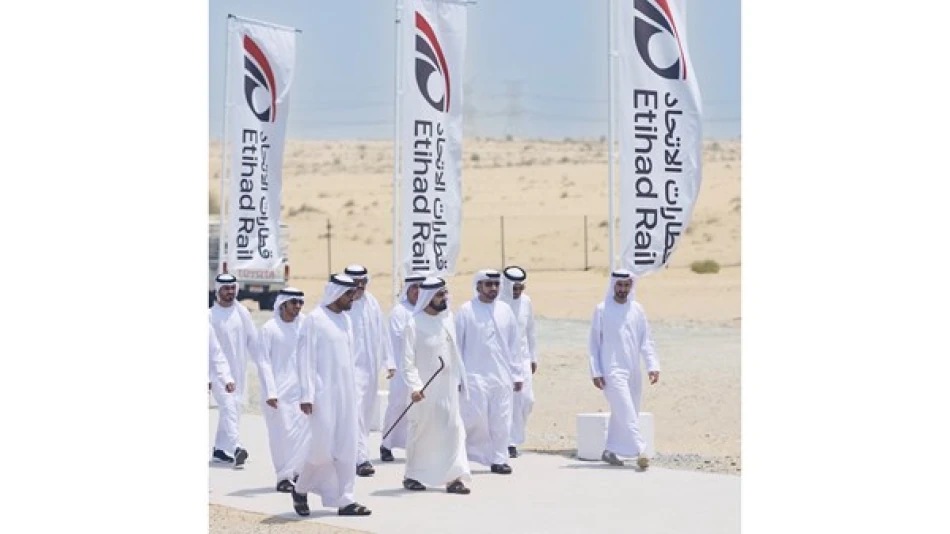
UAE's Economic Lifeline: Sheikh Mohammed Underscores the Union Train's Vital Role in Advancing the Nation's Future
UAE's Sheikh Mohammed Takes Historic Rail Journey as National Train Network Nears Commercial Launch
The UAE's ambitious national railway project reached a symbolic milestone as Vice President and Prime Minister Sheikh Mohammed bin Rashid Al Maktoum personally rode the Etihad Rail passenger service from Dubai to Fujairah. With commercial operations set to begin in 2026, this historic journey signals the Emirates' transformation into a regionally connected transport hub that could reshape logistics and tourism across the Arabian Peninsula.
A Strategic Infrastructure Investment Takes Shape
Sheikh Mohammed's journey aboard the passenger train represents more than ceremonial validation—it demonstrates the UAE's commitment to diversifying its economy beyond oil through strategic infrastructure development. The ruler praised the project as "an important economic artery and vital bridge that enhances the UAE's journey toward the future," positioning it as a cornerstone of the nation's logistics ambitions.
The timing is significant. As global supply chains face ongoing disruptions and regional competitors like Saudi Arabia invest heavily in transport infrastructure through NEOM and other megaprojects, the UAE is positioning itself as the Gulf's primary logistics gateway. This railway network directly supports that vision by creating seamless connectivity between major emirates and economic zones.
Market Impact and Economic Implications
Passenger Capacity and Revenue Potential
The numbers reveal the project's commercial ambitions. Each train will accommodate 400 passengers and operate at speeds up to 200 kilometers per hour. By 2030, the network expects to transport 36.5 million passengers annually—a figure that would make it one of the Middle East's busiest rail systems.
For investors, this represents a significant shift in regional transport economics. The passenger rail service complements the already operational freight network launched in 2023, creating a dual-revenue stream that enhances the project's financial viability. Tourism operators, real estate developers, and logistics companies are likely to benefit from improved connectivity between emirates.
Regional Competitive Positioning
The UAE's rail network directly challenges traditional regional transport models. Unlike Saudi Arabia's still-developing projects or Qatar's limited Doha Metro, the Emirates is creating an inter-city network that connects diverse economic zones—from Dubai's financial district to Fujairah's industrial ports.
This connectivity advantage could prove decisive for businesses choosing regional headquarters. Companies can now access both Dubai's financial services and the UAE's industrial facilities via efficient rail transport, reducing logistics costs and improving operational flexibility.
Environmental Strategy Meets Economic Development
The railway project aligns with the UAE's 2050 net-zero climate goals, offering a lower-carbon alternative to road transport. This environmental positioning is increasingly important as international companies face pressure to reduce their supply chain emissions.
Sheikh Dhiyab bin Mohammed bin Zayed Al Nahyan, Chairman of Etihad Rail, emphasized this dual benefit, noting how the project supports both national development and sustainability objectives. For multinational corporations operating in the region, this rail network provides a tangible way to reduce their carbon footprint while maintaining operational efficiency.
The Broader Infrastructure Vision
The passenger service represents the latest phase of a comprehensive transport strategy that began with the "Projects of the 50" initiative in 2021. The network will ultimately connect 11 cities and regions from Al Sila to Fujairah, creating an integrated transport corridor spanning the entire UAE.
This level of connectivity mirrors successful models in Europe and East Asia, where high-speed rail networks have transformed regional economics. The UAE's version, adapted for Gulf conditions and distances, could establish a template for similar projects across the Middle East.
Investment and Development Timeline
With commercial passenger operations scheduled for 2026, the project timeline reflects the UAE's characteristic approach to infrastructure development—ambitious but achievable targets backed by substantial investment. The first four stations in Abu Dhabi, Dubai, Sharjah, and Fujairah will anchor the initial network, with expansion planned as demand grows.
For regional transport companies and international rail operators, this timeline creates specific business opportunities. The UAE's approach of combining public investment with private sector expertise offers a model that other Gulf states may replicate, potentially creating a broader regional market for rail technology and services.
The success of this passenger rail network will likely influence similar infrastructure decisions across the GCC, making the UAE's 2026 launch a critical test case for regional transport integration. Early performance metrics will determine whether other Gulf states accelerate their own rail investments or adjust their strategies based on UAE market response.
Most Viewed News

 Layla Al Mansoori
Layla Al Mansoori






